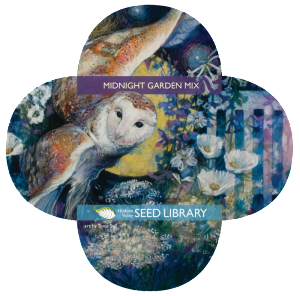After the last human gardener closes the gate and heads home for the evening, other species of gardeners continue working through the night. Most of us are familiar with the buzz of pollinators that keep the same hours – working alongside us in warm sunlight to collect nectar and cross-pollinate crops. But, at dusk and beyond, the work does not stop and a new team of pollinators takes over. Night pollinators can withstand colder temperatures and have better vision than their daytime counterparts. To accommodate the nocturnal hours they keep, some flowers have evolved to attract them. And in turn, we created the Midnight Garden Mix to accommodate them and turn our gardens into the best night clubs for these nocturnal critters.
 In the northeast, moths make up the biggest night pollinator population. In fact, many bugs that we consider pests in their larvae or caterpillar stage grow into helpful pollinators once they reach moth-hood. The Noctuids – the biggest butterfly and moth family, for example, includes the dreaded cutworms and corn earworms. Varieties of Sphinx moths, which are some of the most interesting night pollinators to observe, start out as tomato or tobacco hornworms. The Sphinx moths are unique in their ability to hover, beating their wings very quickly, and their long proboscis (or tusk) - qualities that sometimes get them mistaken for baby hummingbirds.
In the northeast, moths make up the biggest night pollinator population. In fact, many bugs that we consider pests in their larvae or caterpillar stage grow into helpful pollinators once they reach moth-hood. The Noctuids – the biggest butterfly and moth family, for example, includes the dreaded cutworms and corn earworms. Varieties of Sphinx moths, which are some of the most interesting night pollinators to observe, start out as tomato or tobacco hornworms. The Sphinx moths are unique in their ability to hover, beating their wings very quickly, and their long proboscis (or tusk) - qualities that sometimes get them mistaken for baby hummingbirds.
 During daylight, flowers use their bright colors to attract pollinators, but at night, bright colors fade to black and grey. Night blooming varieties are white or pale, utilizing the reflection of the moonlight instead to appear visible to pollinators. Fragrance is another important quality night blossoms posses – a strong, often sweet odor allows critters of the night to locate the blooms. Some flowers in this category only bloom in the evening hours, while others remain open all day and night, but release the most nectar after dark.
During daylight, flowers use their bright colors to attract pollinators, but at night, bright colors fade to black and grey. Night blooming varieties are white or pale, utilizing the reflection of the moonlight instead to appear visible to pollinators. Fragrance is another important quality night blossoms posses – a strong, often sweet odor allows critters of the night to locate the blooms. Some flowers in this category only bloom in the evening hours, while others remain open all day and night, but release the most nectar after dark.
 Our Midnight Garden Mix is filled with such fragrant, delicate, shimmery lunar landing pads, including: Candytuft, White Four O'Clocks, White Cosmos, Sweet Mignonette, Bishop's Flower, Evening Scented Stock, Sensation Mixed Nicotiana. The dreamy, dark landscape on this Art Pack was created by artist Tonja Sell. Tonja is an artist working in several mediums who derives her living from her art. She attended the Milwaukee Institute of Art & Design and has done free-lance illustration, children's books and gallery work for the past 25 years. Together with her husband and four children, she lives in the wilds of Northwestern Wisconsin near the shores of beautiful Lake Superior. Tonja is also an avid flower gardener and love growing our own food for my family.
Our Midnight Garden Mix is filled with such fragrant, delicate, shimmery lunar landing pads, including: Candytuft, White Four O'Clocks, White Cosmos, Sweet Mignonette, Bishop's Flower, Evening Scented Stock, Sensation Mixed Nicotiana. The dreamy, dark landscape on this Art Pack was created by artist Tonja Sell. Tonja is an artist working in several mediums who derives her living from her art. She attended the Milwaukee Institute of Art & Design and has done free-lance illustration, children's books and gallery work for the past 25 years. Together with her husband and four children, she lives in the wilds of Northwestern Wisconsin near the shores of beautiful Lake Superior. Tonja is also an avid flower gardener and love growing our own food for my family.
 A white sheet and a lightbulb is one simple way to get to know the night gardeners. (Image: awaytogarden.com)
A white sheet and a lightbulb is one simple way to get to know the night gardeners. (Image: awaytogarden.com)Most night pollinators actually fall into the crepuscular category, a word that’s derived from crepusculum – meaning twilight – and are most active around dusk and dawn, not the dead of the night. That’s good news for sleepy and curious gardeners want to catch a glimpse of these bugs. Many night pollinators keep a very regular schedule and come back to the same spots every night. For more suggestions on how and why to go mothing, take a look at Margaret Roach’s Q+A with moth expert Seabrooke Leckie.






